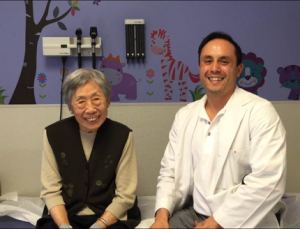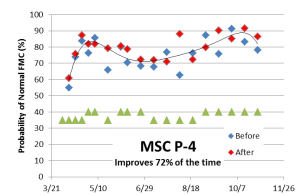An evidence-based study of acupuncture as a holistic therapeutic intervention
January 25, 2017
 Case study of chronic pain co-morbid with chronic anxiety
Case study of chronic pain co-morbid with chronic anxiety
by Donald Lefeber MAOM, LAc, BA; Jiazhen Li MAOM, LAc, MD; and William C. Paske PhD The Netherlands Study of Depression and Anxiety (NESDA) suggests a reciprocal relationship exists between chronic pain, depression, and anxiety because they share the same pathophysiological pathways.1,2 This case examines a 90-year-old female with co-morbid condition of chronic low back pain and chronic anxiety and the utilization of acupuncture as an holistic intervention. METHODS Evidence based evaluations are utilized with RU-Fit medical device and Geriatric Anxiety Scale (GAS) version 2.0 RU-Fit™, is an FDA approved instrument to measure fine motor coordination. It collects data and measurements associated with fine motor control (FMC), coordination variance, reaction time and strength in four one-minute tests before and after acupuncture treatments. GAS assessed degree of anxiety of patient before starting acupuncture treatments and after a three-month period of acupuncture treatments.10 Patient received acupuncture treatments at Hope Clinic, Bellaire Texas, one time per week for 6 consecutive weeks, then every other week and occasionally consecutive weeks. Case description The patient is a 90-year-old woman with chronic low back pain due to osteoarthritis, co-morbid with chronic anxiety. Amelioration of the patient’s condition has remained a constant challenge for years with limited treatment success. Acupuncture treatments were from April 2, 2016 to October 29, 2016. Systems Review - Observation: Pronounced hunch back with abnormal and slow gait; required assistance of others for mobility in her walker.
- Head, EENT: Acid reflux every two to three days.
- Genito-urinary: Wakes up four times per night to urinate.
- Cardio-pulmonary: HTN over 50 years, high cholesterol 30 years.
- Temperature/perspiration: Sensitive to cold temperatures.
- Bowel movement: three times per week, feels bloating regularly.
- Diet & nutrition: Eats nutritious and balanced diet with home cooked foods, however craves sweets and rich foods such as fatty meats.
- Gynecological: 10 pregnancies, five miscarriage.
- Pain: Low back and hip—5/10 pain level when treatment started in April 2016.
- Medical History: Stroke. Depression diagnosed in March 2016. Dementia, short-term memory problems (first noticed after started to take laxatives…patient’s caretaker believes there was connection between dehydration and onset of dementia). Osteoarthritis for 20 years.
- Current medications and supplements: HTN medications used 50 years, cholesterol medications used 30 years.
- Nifedipine ER 60mg, Nexium 40mg, Metoprolol ER 100mg, Simvastin 20mg, Atenolol.
- Medication dosage has remained constant throughout duration of acupuncture treatments.
- 1st treatment: Patient felt less: lower back pain, urination at night and frequency of acid reflux.
- 4th treatment: No complaints of lower back pain, experienced increase in leg strength, less swelling and numbness of the ankles. There was increase in the range of motion of back with improved posture, gait and autonomous mobility of the patient. Anecdotal evidence from patient’s daughter reported “she can get in and out of bed without help.” She also mentioned, “after the first month of treatment, alongside increased levels of physical and social activities, the patient experienced a transformation in mood, demeanor, mental health and patient’s inner will and strength in the form of stronger desires. Patient reported appreciating life and being happy for the first time in many years.
- 7th treatment: No complaints of acid reflux in past week. Consistent increases in energy levels (up to four hours of physical activity per day) lasting several days after treatment.
- 10th treatment: Balance and coordination are reportedly better. Patient has depended less on walker. She demonstrated picking up a piece of food off the ground by bending over while balancing on one leg.
- 11th to 16th treatment: Maintained overall increased levels of physical activity and decreased levels and episodes of anxiety.
 RU-Fit™ testing started on April 11, 2016 (2nd treatment). FMC After three months of acupuncture treatments GAS scores improved from a total score of 54 to 34 (37 percent improvement). Improvements in GAS subscale scores occurred most in affective (47.4 percent) followed by somatic (47.1 percent) and cognitive (16.7 percent) scores respectively.
RU-Fit™ testing started on April 11, 2016 (2nd treatment). FMC After three months of acupuncture treatments GAS scores improved from a total score of 54 to 34 (37 percent improvement). Improvements in GAS subscale scores occurred most in affective (47.4 percent) followed by somatic (47.1 percent) and cognitive (16.7 percent) scores respectively. | Subscale | Before Acupuncture (Before April 2016) | After Acupuncture (July 23, 2016) |
| Somatic | 17 | 9 (47.1 percent change) |
| Cognitive | 18 | 15 (16.7 percent change) |
| Affective | 19 | 10 (47.4 percemt change) |




















SHARE